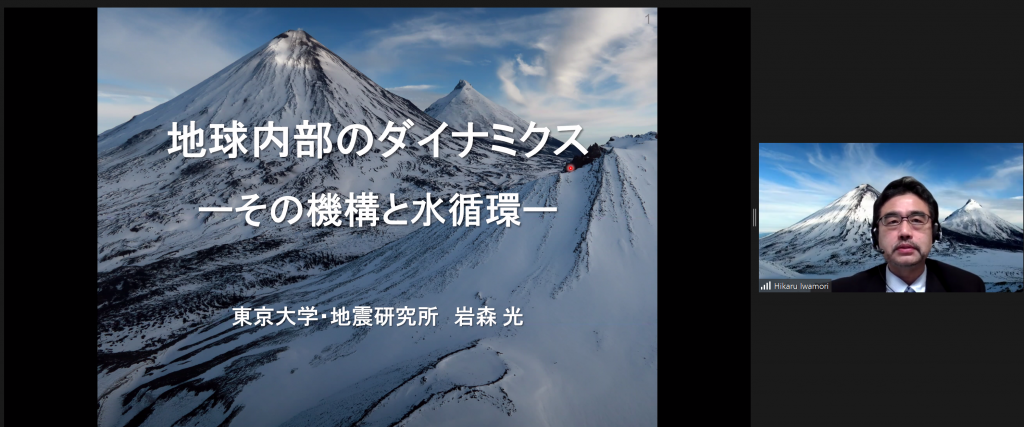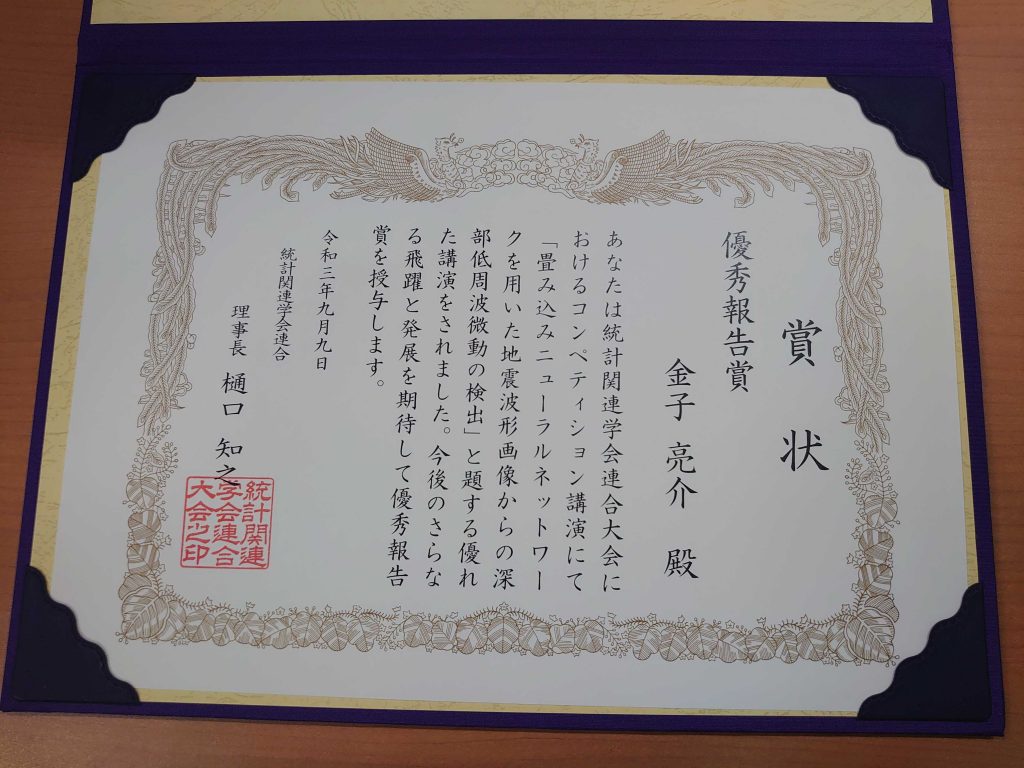地震研究所と参加者とのコミュニケーション促進の場である「懇談の場」が2021年9月28日にオンラインで開催されました。「表層が地球ダイナミクスを駆動?」について、物質科学系研究部門の岩森 光教授によるお話で、所内外の方々約23名の参加がありました。

地震研究所と参加者とのコミュニケーション促進の場である「懇談の場」が2021年9月28日にオンラインで開催されました。「表層が地球ダイナミクスを駆動?」について、物質科学系研究部門の岩森 光教授によるお話で、所内外の方々約23名の参加がありました。

谷部功将特任研究員が、アメリカ地球物理学連合のMineral Physics SectionにおけるGraduate Research Awardを受賞しました。 https://eos.org/agu-news/2021-agu-section-awardees-and-named-lecturers
悪原 岳, 中東和夫(東京海洋大学), 篠原雅尚,山田知朗, 塩原 肇, 山下裕亮(京都大学防災研究所), 望月公廣, 植平賢司(防災科学技術研究所)
Lithosphere–asthenosphere boundary beneath the Sea of Japan from transdimensional inversion of S‑receiver functions
Earth, Planets and Space (2021) 73:171 DOI: 10.1186/s40623-021-01501-5
今から2300–1500万年ほど前、日本列島はユーラシア大陸から引き離されるようにして誕生し、日本海も一緒に形成されました。日本海は、北部に位置する日本海盆、南東部および南西部に位置する大和海盆と対馬海盆、そして中央部に位置する大和堆に大別することができ、それぞれの形成過程が議論されてきました。日本海盆の地殻は典型的な特徴を示し、よくある海洋底拡大のプロセスで形成されたと考えられています。一方で、大和海盆や対馬海盆の地殻は異常に厚いことが知られており、その成因は議論の的となっています。本研究では、地殻より深部の上部マントル構造に、海盆の形成プロセスの手掛かりを探しました。
日本海ではこれまでに、海底地震計による地震観測が行われており、地震波形記録が取得されています。地球内部を伝わる地震波は、物質の境界層を通過する際に、S波からP波(あるいはその反対)へと波の性質が変化します。本研究では,海洋プレートの底部でS波からP波へと変換する波を解析することで、プレートの厚さを求めました。その結果、日本海盆と大和海盆では、地殻の厚さが大きく異なるにもかかわらず、プレートの厚さ自体はほとんど変わらないことが分かりました。このことは、大和海盆も日本海盆と同じように、海洋底の拡大によって誕生したことを示唆します。また、大和堆の下ではプレートの厚さが顕著に厚くなっていることが明らかになりました。これは、大和堆がユーラシア大陸の名残であるためと考えられます―大陸プレートは一般的に海洋プレートよりも厚くなっています。
日本海のプレート構造を明らかにすることは、日本海の成り立ちを知るためだけでなく、日本海の東縁部に沿った大地震の発生帯(いわゆる、ひずみ集中帯)の機構を理解するためにも役立ちます。今後、海域地震観測のさらなる充実により、より詳細なプレート構造を明らかにする必要があります。
本研究(海域地震観測も含む)は、文部科学省「日本海地震・津波調査プロジェクト」の一環として行われました。
金子亮介(修士2年)が、統計関連学会連合優秀報告賞を受賞しました。

受賞者氏名:金子亮介(大学院情報理工学系研究科 数理情報学専攻)
受賞名 :優秀報告賞
授与機関 :統計関連学会連合
受賞日 :2021年9月9日
研究題目 :畳み込みニューラルネットワークを用いた地震波形画像からの深部低周波微動の検出
佐竹健治 所長が、本学ウエブサイトのDiscover our peopleで紹介されました。ぜひご覧ください。
Discover Our People – https://www.youtube.com/watch?v=CrlNbCPWNW4
令和3年度地震火山災害予防賞公募のお知らせ【締切】R3.11.19(金)午後5時
Abstract:
Earthquake hazard assessments for the Tokyo Region are complicated by the trench-trench triple junction where the oceanic Philippine Sea Plate not only underthrusts a continental plate but is also being subducted by the Pacific Plate. Great thrust earthquakes and associated tsunamis are historically recognized hazards from the Continental/Philippine Sea (Sagami Trough) and Continental/Pacific (Japan Trench) plate boundaries but not from the Philippine Sea/Pacific (Izu-Bonin Trench) boundary alone. Here we implicate possible ruptures along these three plate boundaries in generating an unusually large tsunami from sandy deposits found along 50 km of coastline east of Tokyo. Dating to about 1,000 years ago, this inferred tsunami predates local written history by several hundred years. We find that the inland extent of its sand sheet is best explained, in computer simulations, by displacement on one of the three plate boundaries offshore of the Boso Peninsula, corresponding to the triple junction. The minimum magnitude scenario capable of generating the inland extent of inundation involves displacement along the Philippine Sea/Pacific boundary megathrust. This plate-boundary fault adds another potential source for earthquakes in the Tokyo Region and tsunamis in the Pacific Ocean.
ニュースレターPLUSのNo.36(2021年9月号)特集:表層が地球ダイナミクスを駆動?が刊行されました。刊行に合わせて懇談の場も開催されます。